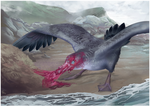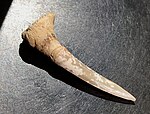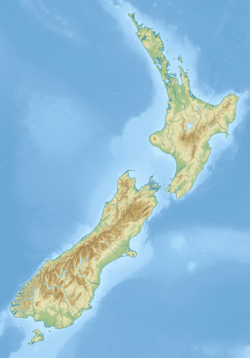Tangahoe Formation
| Tangahoe Formation | |
|---|---|
| Stratigraphic range: Middle Pliocene ~ | |
 Exposed rock at Waihi Beach Reserve, South Taranaki, New Zealand | |
| Lithology | |
| Primary | Mudstone |
| Location | |
| Coordinates | 39°30′S 174°50′E / 39.500°S 174.833°E |
| Region | Taranaki |
| Country | New Zealand |
| Extent | Wanganui Basin, North Island |
The Tangahoe Formation is a geologic formation in the southwestern North Island of New Zealand.
The formation occurs in the Taranaki and Manawatu-Wanganui Regions, spreading in an east–west band for 200 kilometres (120 mi) from the volcanic deposits of Mount Taranaki in the west to the Ruahine Ranges in the east, in a band with an average width of around 20 kilometres (12 mi).[1] It becomes exposed at its western end close to the Tasman Sea coast near Hāwera in a series of cliff faces.[2] The formation takes its name from the Tangahoe River, close to the exposed cliffs.
The formation is sedimentary, composed largely of muddy sandstones, and was formed beneath sea level in the Waipipian stage of the mid-Pliocene some 3.4 to 3.0 million years ago.[2]
Fossil content
Color key
|
Notes Uncertain or tentative taxa are in small text; |
The formation is an important fossil site. Many marine fossils have been recovered from its mudstones, including the megalodon shark, giant petrel Macronectes tinae, penguin Eudyptes atatu, monk seal Eomonachus belegaerensis, and cetaceans.[3][4]
Mammals
| Mammals reported from the Tangahoe Formation | |||||
|---|---|---|---|---|---|
| Genus | Species | Presence | Material | Notes | Images |
| Delphinidae indet.[5] | Indeterminate | Waihi Beach | Mandible. | A dolphin, probably from a species of Delphinus or Stenella. | |
| Eomonachus[6] | E. belegaerensis | Northwest of Waihi Stream on Ohawe and Waihi Beaches. | Skull elements. | A monk seal. | |
Birds
| Birds reported from the Tangahoe Formation | |||||
|---|---|---|---|---|---|
| Genus | Species | Presence | Material | Notes | Images |
| Aldiomedes[7] | A. angustirostris | Ohawe Beach. | Skull. | An albatross. | |
| Ardenna | A. buchananbrowni[8] | Ohawe & Waihi beaches. | 2 partial skeletons. | A shearwater. | |
| A. davealleni[9] | Ohawe Beach. | Partial skeleton. | A shearwater. | ||
| Eudyptes[10] | E. atatu | No exact locality record. | Multiple partial skeletons. | A penguin. | |
| Eudyptula[11] | E. wilsonae | No exact locality record. | Skulls. | A penguin. | |
| Macronectes[4] | M. tinae | Hawera. | Skull & humerus. | A petrel. |  |
| Pelagornithidae[12] | Undescribed | Waihi Beach. | Partial humerus & radius. | An unnamed species of pseudotooth bird. | |
| Procellaria[13] | P. altirostris | Ohawe Beach. | Partial skeleton. | A petrel. | |
| Tereingaornis[14] | T. moisleyi | Waihi Beach. | Left humerus & coracoid. | A penguin, now deemed a nomen dubium.[15] | |
Fish
| Fish reported from the Tangahoe Formation | |||||
|---|---|---|---|---|---|
| Genus | Species | Presence | Material | Notes | Images |
| Carcharodon[16] | C. megalodon | Hawera. | Vertebrae. | Species now moved to Otodus. | |
| Ikamauius[17] | I. ensifer | Waihi Beach. | Rostral denticle. | A sawshark. | |
| Otodus[16] | O. megalodon | Hawera. | Vertebrae. | A megatooth shark, originally reported as Carcharodon megalodon. |  |
| Pristiophorus[18] | P. lanceolatus | Northwest of the Tangahoe River mouth. | Rostral denticle. | Species now deemed a nomen dubium, specimen reassigned as P. sp.[19] | |
| P. sp. | Northwest of the Tangahoe River mouth. | Rostral denticle. | A sawshark, originally reported as P. lanceolatus. |  | |
| cf. Tetrosomus[20] | cf. T. sp. | Waihi Beach | A near-complete articulated specimen. | A boxfish. | |
Invertebrates
| Invertebrates reported from the Tangahoe Formation | |||||
|---|---|---|---|---|---|
| Genus | Species | Presence | Material | Notes | Images |
| Palaega[21] | P. kakatahi | Between Raukawa Falls & Kakatahi. | A single specimen. | A cirolanid isopod. | |
References
- ^ Kamp, P. J. J., et al. (2023) "Geology map of western North Island, showing the main stratigraphic units in the Taranaki, King Country and Wanganui basins," www.researchgate.net. Accessed 9 February 2023.
- ^ a b Naish, T. R., et al. (2005) "An integrated sequence stratigraphic, palaeoenvironmental, and chronostratigraphic analysis of the Tangahoe Formation, southern Taranaki coast, with implications for mid-Pliocene (c. 3.4–3.0 Ma) glacio-eustatic sea-level changes," Journal of the Royal Society of New Zealand, 35(1&2), 151-196. Accessed 9 February 2023.
- ^ Lambert, R., "Taranaki region - Geology and climate," Te Ara - the Encyclopedia of New Zealand Accessed 9 February 2023.
- ^ a b Tennyson, A.J.D.; Salvador, R.B. (2023). "A New Giant Petrel (Macronectes, Aves: Procellariidae) from the Pliocene of Taranaki, New Zealand". Taxonomy. 3 (1): 57–67. doi:10.3390/taxonomy3010006. hdl:10037/29075.
- ^ McKEE, J. W. A.; Fordyce, R. Ewan (1987). "Dolphin mandible (Delphinidae) from the Waipipian Stage (Pliocene), Waihi Beach, Taranaki, New Zealand (Note)". New Zealand Journal of Geology and Geophysics. 30 (3): 321–323. doi:10.1080/00288306.1987.10552627. ISSN 0028-8306.
- ^ Rule, James P.; Adams, Justin W.; Marx, Felix G.; Evans, Alistair R.; Tennyson, Alan J. D.; Scofield, R. Paul; Fitzgerald, Erich M. G. (2020-11-11). "First monk seal from the Southern Hemisphere rewrites the evolutionary history of true seals". Proceedings of the Royal Society B: Biological Sciences. 287 (1938): 20202318. doi:10.1098/rspb.2020.2318. ISSN 0962-8452. PMC 7735288. PMID 33171079.
- ^ Mayr, Gerald; Tennyson, Alan J. D. (2020-07-16). "A small, narrow-beaked albatross from the Pliocene of New Zealand demonstrates a higher past diversity in the feeding ecology of the Diomedeidae". Ibis. 162 (3): 723–734. doi:10.1111/ibi.12757. ISSN 0019-1019.
- ^ Tennyson, Alan J. D.; Salvador, Rodrigo B.; Tomotani, Barbara M.; Marx, Felix G. (2024). "A New Diving Pliocene Ardenna Shearwater (Aves: Procellariidae) from New Zealand". Taxonomy. 4 (2): 237–249. doi:10.3390/taxonomy4020012. hdl:10037/33366. ISSN 2673-6500.
- ^ Tennyson, Alan J.D.; Mannering, Al A. (January 2018). "A new species of Pliocene shearwater (Aves: Procellariidae) from New Zealand". Tuhinga. 29: 1–19.
- ^ Thomas, Daniel B.; Tennyson, Alan J. D.; Scofield, R. Paul; Heath, Tracy A.; Pett, Walker; Ksepka, Daniel T. (2020-08-12). "Ancient crested penguin constrains timing of recruitment into seabird hotspot". Proceedings of the Royal Society B: Biological Sciences. 287 (1932). doi:10.1098/rspb.2020.1497. ISSN 0962-8452. PMC 7575517. PMID 32781949.
- ^ Thomas, Daniel B.; Tennyson, Alan J.D.; Marx, Felix G.; Ksepka, Daniel T. (2023). "Pliocene fossils support a New Zealand origin for the smallest extant penguins". Journal of Paleontology. 97 (3): 711–721. doi:10.1017/jpa.2023.30. ISSN 0022-3360.
- ^ McKee, Joseph W. A. (1985). "A pseudodontorn (Pelecaniformes: Pelagornithidae) from the middle Pliocene of Hawera, Taranaki, New Zealand". New Zealand Journal of Zoology. 12 (2): 181–184. doi:10.1080/03014223.1985.10428278. ISSN 0301-4223.
- ^ Tennyson, Alan James Drummond; Tomotani, Barbara Mizumo (2021-01-29). "A new fossil species of Procellaria (Aves: Procellariiformes) from the Pliocene of New Zealand". Papéis Avulsos de Zoologia. 61: e20216116. doi:10.11606/1807-0205/2021.61.16. ISSN 1807-0205.
- ^ McKee, Joseph W.A. (1987). "The occurrence of the Pliocene penguin Tereingaornis moisleyi (Sphenisciformes: Spheniscidae) at Hawera, Taranaki, New Zealand". New Zealand Journal of Zoology. 14 (4): 557–561. doi:10.1080/03014223.1987.10423029. ISSN 0301-4223.
- ^ Thomas, Daniel B.; Ksepka, Daniel T.; Holvast, Emma J.; Tennyson, Alan J. D.; Scofield, Paul (2020-07-02). "Re-evaluating New Zealand's endemic Pliocene penguin genus". New Zealand Journal of Geology and Geophysics. 63 (3): 324–330. doi:10.1080/00288306.2019.1699583. ISSN 0028-8306.
- ^ a b McKee, JWA (1994). "Carcharodon megalodon vertebrae from the Pliocene Tangahoe Formation, Hawera, New Zealand-with an estimation of the shark size based on these vertebrae". Geological Society of New Zealand Miscellaneous Publication. 80A: 124.
- ^ Keyes, I.W. (1979). "Ikamauius , a new genus of fossil sawshark (Order Selachii: Family Pristiophoridae) from the Cenozoic of New Zealand". New Zealand Journal of Geology and Geophysics. 22 (1): 125–129. doi:10.1080/00288306.1979.10422558. ISSN 0028-8306.
- ^ Keyes, I. W. (1982). "The Cenozoic sawshark Pristiophorus lanceolatus (Davis) (Order Selachii) of New Zealand and Australia, with a review of the phylogeny and distribution of world fossil and extant Pristiophoridae". New Zealand Journal of Geology and Geophysics. 25 (4): 459–474. doi:10.1080/00288306.1982.10421510. ISSN 0028-8306.
- ^ Engelbrecht, Andrea; Mörs, Thomas; Reguero, Marcelo A.; Kriwet, Jürgen (2017-08-18). "A new sawshark, Pristiophorus laevis , from the Eocene of Antarctica with comments on Pristiophorus lanceolatus". Historical Biology. 29 (6): 841–853. doi:10.1080/08912963.2016.1252761. ISSN 0891-2963. PMC 5447807. PMID 28579693.
- ^ Gottfried, Michael D.; Tennyson, Alan J. D. (2023-10-04). "A Pliocene boxfish (Tetraodontiformes, Ostraciidae) from New Zealand – a preview of future environmental change?". Journal of the Royal Society of New Zealand. 54 (5): 602–608. doi:10.1080/03036758.2023.2256681. ISSN 0303-6758. PMC 11459821.
- ^ Feldmann, Rodney M.; Rust, Seabourne (2006). "Palaega kakatahi n. sp.: The first record of a marine fossil isopod from the Pliocene of New Zealand". New Zealand Journal of Geology and Geophysics. 49 (4): 411–415. doi:10.1080/00288306.2006.9515177. ISSN 0028-8306.

